Mikem Member Username: Mikem Post Number: 1389 Registered: 10-2003 Posted From: 68.43.12.165 |
Sven, I found a picture of that building at 5757 Trumbull that belongs to Iron Mountain. Remember I said I could see a "W" on the watertank? Well, it was designed by Albert Kahn and served as a warehouse and office for Westinghouse Electric & Manufacturing Co: 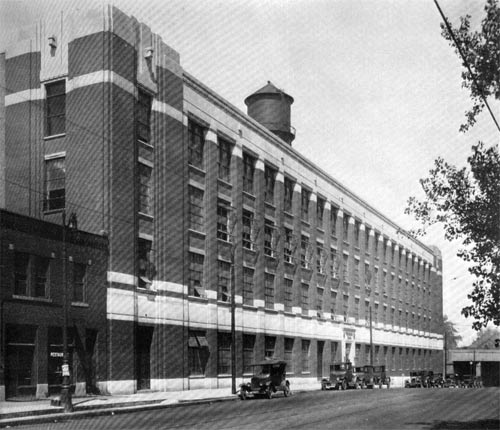 | ||||||||||||||||||||||||
Aiw Member Username: Aiw Post Number: 3700 Registered: 10-2003 Posted From: 67.71.66.90 |
That picture looks familiar Mike... I see someone got their new book  | ||||||||||||||||||||||||
Jjaba Member Username: Jjaba Post Number: 1638 Registered: 11-2003 Posted From: 24.22.6.155 |
Many of us remember the Detroit Creamery delivering with horse and buggy. It was an era of Italian knife sharpeners who pushed carts down our Detroit streets. Then came the Twin Pines milkman with his Divco Truck. Same for the laundry deliveries and the flower shops. Same for the bakery wagons and the newspapers. It was Divco with the goods. Some compare the legacy of the VW Beetle with the Divco Truck as American iconography. Divco produced trucks for 61 yrs. so we got to know their looks. (1925-1986) Divco means Detroit Industrial Vehicle Company. The "D" is Detroit and yes they did have a new 1937 plant out on Hoover Rd. somewhere on that Eastside of Detroit unknown to jjaba. In 1922, George Bacon invented his truck in electric mode. He worked at Detroit Electric Vehicle Company. His idea was that you drive the truck jumping in and out for route deliveries. There were four places to drive the truck; left and right bumpers, front and rear inside controls. Depended upon what you were doing with the truck. The onliest problem was low power from batteries. You stood when you drove it. The main pedal was both clutch, brake, and acceleration. So George Bacon started his own company using gasoline and diesel power. He and his successors used all manners of engines including Le Roi, Continental, Ford, Nash, Caterpillar, Devitz, and Detroit diesels. Divcos came in model letters. The Model A came out in 1926. It had a Continental engine with Warner 4 speed transmission. The DIVCO Detroit Company went to Model G and H by 1929 and in the 1930s was already up to Model S. Financial troubles were always with this DIVCO outfit. In 1936, they were forced to become Twin Coach Co. out of someplace called Kent, Ohio. In 1939, they put out Model U. In 1957, Wayne Works who made buses bought DIVCO, kept the name, and made the trucks in Richmond, Indiana. DIVCO-Wayne was bought by Boise-Cascade in 1968. B-C makes paper but vertically integrated to use DIVCO trucks for deliveries of office supplies. Crazy, eh? That would be like Morton Salt buying Charmin since they used it in their bathrooms. In the 1960s DIVCO came with Nash gasoline engines or Detroit Diesel 3-cylinders. More changes in ownership and in 1968 to 1986 they finally ended up in Delaware, Ohio to banckrupcy. In 1969, DIVCO Trucks are being produced by Correct Manufacturing Company in Delaware, Ohio until they went kaput in 1986. They had one dealer left in 1986, Tri-City DIVCO Sales, Rock Island, Illinois. For more info. read about it with DIVCO geeks at www.DIVCO.org. They are collectors of the dandy machines. jjaba, research dept. | ||||||||||||||||||||||||
Jjaba Member Username: Jjaba Post Number: 1639 Registered: 11-2003 Posted From: 24.22.6.155 |
Divco again. The Divco East Truck Show is being held in Grantville, Pa. in early June, 2005. This is part of the milkmen's reunion, sort of like a reunion of old guys from a Battleship. Also, note that Vanette ice cream trucks are being produced by a Divco derivitive today in Delaware, Ohio. The legacy lives! For more info. dial up: www.divco.org. jjaba | ||||||||||||||||||||||||
Mikem Member Username: Mikem Post Number: 1391 Registered: 10-2003 Posted From: 68.43.12.165 |
I'm interested in production line statistics. How long is an actual final assembly line on average? How fast does it move? How many cars per hour or per day are produced? How many plants have more than one final assembly line? I know the answers vary with company, plant, product, and era. What is the usual range for a high selling brand such as Ford, Chevy, Plymouth? Ford Highland Park had four assembly lines. Plymouth Lynch had three at once and Dearborn Assembly had three or four; anyone else have that many? I've seen figures as high as 140 cars/hour from one line. That sounds high, yes, no? Seems like 250,000 autos per year used to be a good number for a plant to be efficient. Now maybe only 160,00 per year? How about the length of time for an auto to be assembled? Putting together a few sources I have about Ford's early assembly lines: "It's of record that in the old Piquette Avenue days, previous to the time when any attempts at Ford shops systemization were made and chaos reigned supreme, the first systematizer found that the Ford [engine] traveled no less than 4,000 feet in the course of finishing, a distance now [1913] reduced to 334 feet." "Ford installed the first moving line at Highland Park on or about May 1, 1913, to assemble magnetos.... ....Ford divided magneto assembly into 29 operations and placed a man along a moving belt to perform each of those operations. The 29 men were able to turn out 132 magnetos per hour -- 1188 magnetos in a 9-hour day -- the equivalent of each worker building a magneto in 13 minutes, 10 seconds. Before the development of the moving line, an individual skilled worker used to take about 20 minutes to collect the needed parts and assemble a complete magneto." "Experiments with the magneto line over the next year achieved further time savings. The line was raised from 27 inches to 35 inches above the floor so that workers could stand upright. A chain-driven line, installed on or about March 1, 1914, enabled 18 men to assemble 1175 magnetos in 8 hours, the equivalent of each worker building one in just over 7 minutes. The initial chain speed of 60 inches per minute proved too fast for the workers, the second speed of 18 inches too slow, the third speed of 44 inches suitable. Once the moving line became familiar to the workers, four men were removed, and the remaining 14 assembled 1335 magnetos in an 8-hour day, the equivalent of each worker building one in only 5 minutes." "Once the motor assembly line was finally completed in November 1913, 1000 motors could be assembled by 472 workers in an 8-hour day, the equivalent of each worker building on in 226 minutes. In comparison, at stationary positions 1000 motors required 1100 men working a 9-hour day, the equivalent of each worker building one in 594 minutes." "In 1909, the last full year at the Piquette plant, Ford produced 13840 cars this way [stationary assembly points], a rate of 7.5 per hour." "At Highland Park, Ford increased production to...89455 in 1912 by setting up more work stations in the larger building, improving the sequence of work, using more machine tools and standardized parts, and designing a car that was easier to build. Ford could assemble 100 chassis simultaneously at fixed locations, with 50 stations along each of two 600-foot lines. In Ford's most productive month so far, August 1913, 330 men working 9 hours per day for 26 days assembled 6182 chassis, the equivalent of 12 hours, 28 minutes per worker per chassis. This was the highest efficiency any vehicle manufacturer achieved using stationary work positions. After the installation of the moving assembly line a year later [January 14, 1914], Ford reduced chassis assembly time by 88%, to 1 hour, 33 minutes per worker." In Ford's early experiments with chassis assembly lines, they ranged in length from 150 feet [men pushing chassis on rollers past workers] to 300 feet with a chain driven line. Maxwell installed an 800 foot line in 1916 that gave them an output of 250 cars per day. Dodge, Hudson, Packard, and Saxon had installed moving lines by 1916 as well. Soon other companies matched Ford's efficiency; Hudson took only 90 minutes to assemble a car in 1926. With further tinkering of the line, the number of man-hours needed to build a Ford car declined from 1260 in 1912 to 228 in 1923. For Ford's Fiftieth anniversary (1953), they put out a book called Ford At Fifty (duh!), with this drawing in the centerfold of the Atlanta assembly line, probably the darling plant outside of Dearborn and one of the most productive: 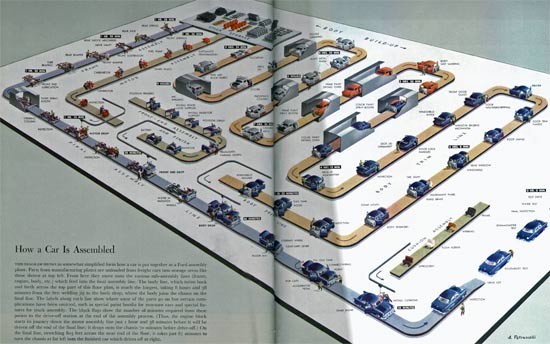 The art work shows essentially five lines: Motor Assembly, Front-End Assembly, Body Build-Up, Cushion Assembly, and of course Final Assembly. Final is divided into Frame Assembly and Final Assembly, and the Body Build-Up is divided into Build-Up, Trim Line and Prep. Here are a few close-ups to demonstrate -- Along each line, at certain points, is shown the time remaining until the car is driven off the end. Body takes the longest and starts 9:24 before the end by throwing the floor-pan on the line: 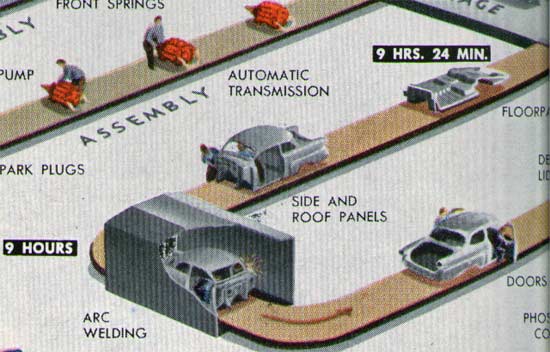 An hour later it's getting its welding job touched up and ready for a phosphate coating: 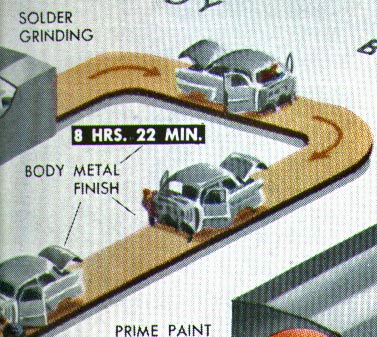 It needs to cool before it gets primed, painted, and sanded over the next 2½ hours: 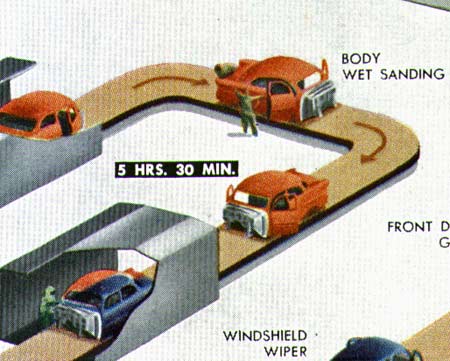 As it winds back and forth through the plant it gets more body components added: 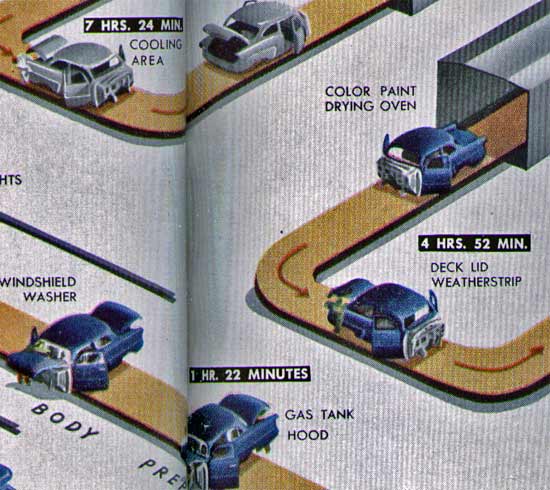 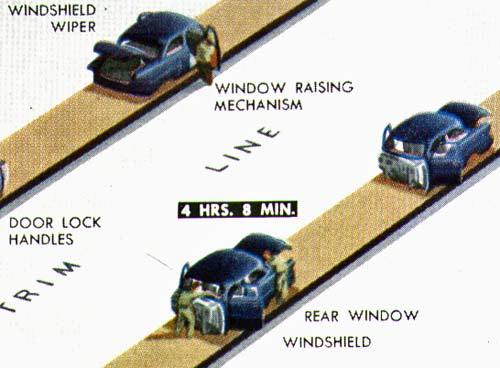 In the meantime, with about two hours to go, the frame is getting started on what turns into the final assembly line, and shortly thereafter, the final motor assembly gets started on a separate line: 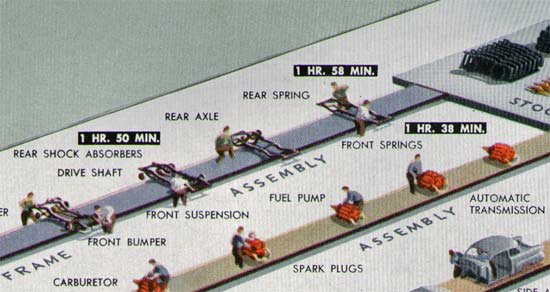 Within half an hour, the frame has been painted and the motor is ready to drop: 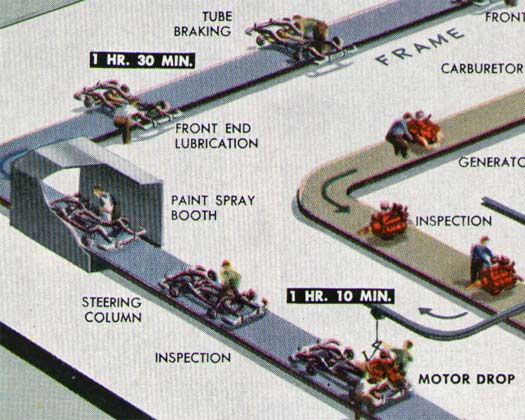 The front-end was being built simultaneously and just 12 minutes after the motor is on the frame, the front-end joins the final line: 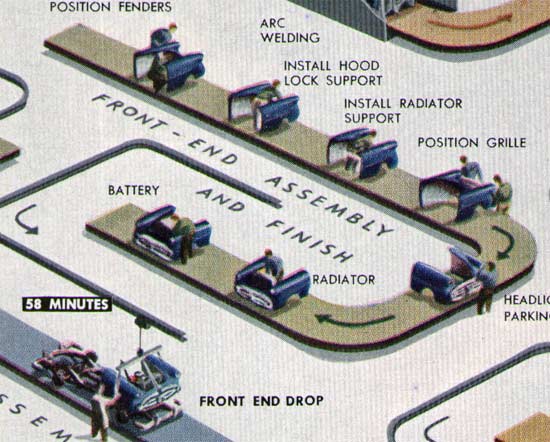 Another 12 minute, now just 46 minutes to go, the body gets dropped: 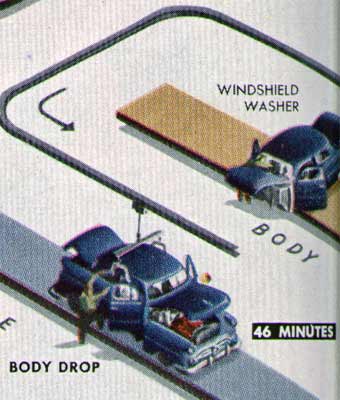 Now it's down to the details and with 10 minutes to go, it finally gets seats installed: 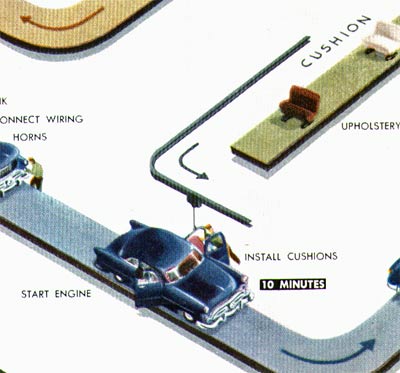 Off she goes to inspection and the rail yard for shipment. The accompanying paragraph tells that the "final line" -- from after the frame is painted to drive off -- is 803 feet and takes 87 minutes. That figures to a line speed of roughly 9.5 feet per minute, or 114 inches per minute. How would that compare to the Taurus line in Atlanta in recent years? | ||||||||||||||||||||||||
Kathleen Member Username: Kathleen Post Number: 434 Registered: 10-2003 Posted From: 69.14.122.57 |
Is this referring to the Ford plant along I-75 south of downtown Atlanta....they make the Taurus and something else...and the street is named after Henry Ford II? How long has that plant been in operation? | ||||||||||||||||||||||||
Mikem Member Username: Mikem Post Number: 1392 Registered: 10-2003 Posted From: 68.43.12.165 |
Yes it is Kathleen. The plant opened in 1946, replacing an earlier Ford plant in Atlanta that operated from 1915 to the start of WWII. Ford never re-acquired it from the government after the war. I understand that it has been converted into lofts and boutique stores and has a historical marker on it. | ||||||||||||||||||||||||
623kraw Member Username: 623kraw Post Number: 601 Registered: 10-2003 Posted From: 68.41.224.200 |
My bad about 6004 Conant. Anywho, here's Iron Mountain: 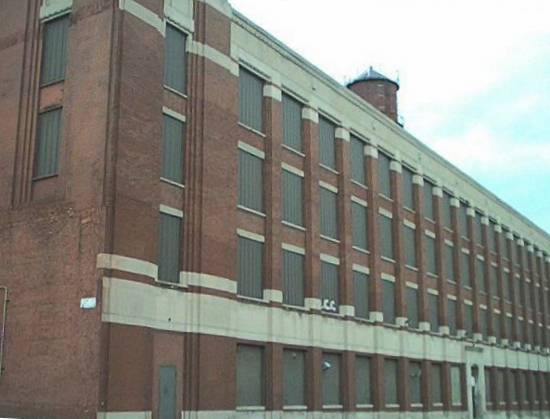 | ||||||||||||||||||||||||
Jjaba Member Username: Jjaba Post Number: 1645 Registered: 11-2003 Posted From: 24.22.6.155 |
MikeM scores big again with these diagrams on production. Merci beaucoups! A couple of yrs. ago, jjaba spent an entire day touring the Olds Works in Lansing. In the assembly building, they were running two lines simultaneously, 3 shifts, and produced 400,000 Pontiac Grand Ams from a single plant. It was quite a sight to see. In olden days when jjaba went on school tours in the post-war 1940s, we were told that Ford made a car a minute at The Rouge. That would be 60 cars an hr. and they were running 24/7. Back then, as today, the foremen controlled the speed. We learned the term, "The Speed Up," where bosses tried to tweek a few cars off per hr. and labor tried to keep the shop honest to the printed contract. Each worker had a pull-cord to stop the line and boy oh boy, you had to have one huge reason to do that, except for times when labor wasn't happy with something. Shop stewards were there to smooth out troubles. As for the Atlanta plant, it one of Ford's crown jewels. It has been producing quality product for 50+ yrs. now and yes, is located on Henry Ford II Avenue, just South of the City. The current run of Ford Tauras and Mercury Sable is legendary. This plant is twinned in production with Chicago Assembly to supply one of Ford's all-time workhorse vehicles. Before Honda and Toyota's popularity, this model led in all USA sales. Thanks again Mike. jjaba really urges you motorheads to give us data on production capacities today, units per hr., and which lines produce what volumes of automobiles. The data out of Honda-Marysville, Ohio must be simply staggering, given the numbers we see on the roads. The same with that Kentucky Toyota plant. Props to those workers. There are one hell of a lot of Ford 150 trucks out there. How many per hr. come off Billy Ford's new Rouge line? In olden days in Detroit, there were parts being slinged from everywhere, chassis driven up and down Fort Street, and a huge RR servicing them. Today, plants have Just In Time parts, often shipped in from the same campus where Final Assembly takes place. In Chicago, Ford is building such an industrial park beside its historic plant on the Southside. The plants are so huge, mostly one-story, and you never see much pre-production units running down the streets. Correct jjaba if he's wrong. jjaba | ||||||||||||||||||||||||
Mikem Member Username: Mikem Post Number: 1395 Registered: 10-2003 Posted From: 68.43.12.165 |
For Kathleen & jjaba: Ford's Original Atlanta Factory | ||||||||||||||||||||||||
Lowell Board Administrator Username: Lowell Post Number: 1149 Registered: 10-2003 Posted From: 66.167.212.185 |
Wow, great stuff gang. Simply awesome. My contribution has to be anecdotal and sociological. For three college summers I built V-8 engines at the Dearborn Engine plant in the Rouge. This was preceded by a summer of assembling large trucks for International Harvester in Fort Wayne, Ind. There were two engine lines that moved up to 180 an hour, or three a minute, so the work you added to the job was minimal and hence very boring. All summer I air hammered eight cylindrical parts into engines blocks that were mounts for the heads that would be next added. Up the line from me the pistons were being slammed in. The line moved slowly but incessantly. You had to side step every two seconds to stay apace, but you could work up and down the line to the length of the your air hose within you 'station'. I found that by working up the line as far as I could I could then let the line pass toward the end of my station and then catch it up again. By doing so I could read a page or two of a book in between and managed to read six or seven books that summer. By contrast the truck line moved at 10 an hour giving you six minutes a vehicle. Hence the jobs were more involved and more interesting. For more complex jobs, like installing a dash panel, you did every other one with a partner giving you 12 minutes. You really felt like you had done something more than turn a nut. My first summer in Detroit I inspected engine block tappet bores at the end of a two hundred feet of milling machines. My job is forever emblazoned on the walls of the DIA [see arrow]. The striking difference between the Rivera mural and my job was that I was the only one around for 50 feet distance. It has all been automated and all I was doing was checking the block, never moving or assembling a thing. 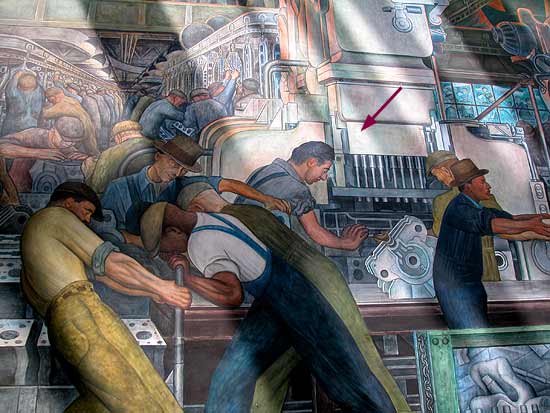 | ||||||||||||||||||||||||
Sven1977 Member Username: Sven1977 Post Number: 67 Registered: 04-2004 Posted From: 209.220.229.254 |
Here are today's Sanborn maps. 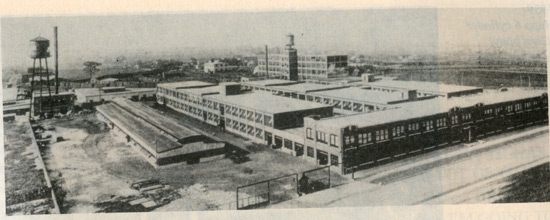 The Hupp factory copied from "How Detroit Became the Automotive Capital."  The Hupp factory in 1915. 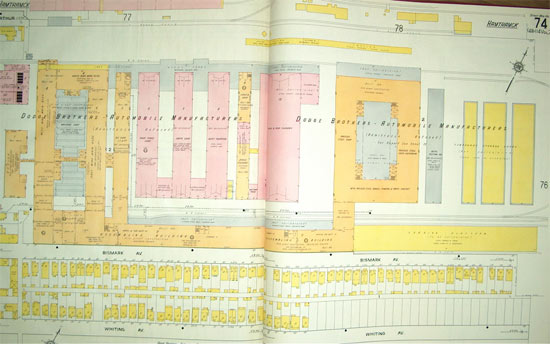 Dodge Main in 1915. | ||||||||||||||||||||||||
Mikem Member Username: Mikem Post Number: 1396 Registered: 10-2003 Posted From: 68.43.12.165 |
Dodge Main layout: 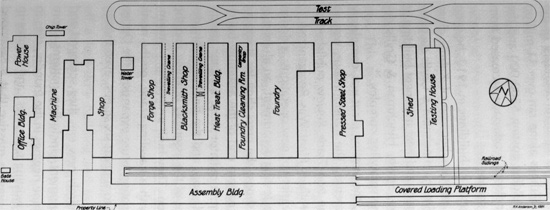 Hupp, looking northeast: 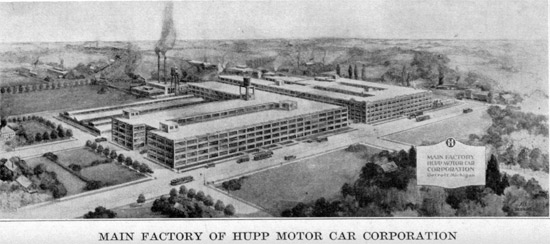 | ||||||||||||||||||||||||
Mikem Member Username: Mikem Post Number: 1397 Registered: 10-2003 Posted From: 68.43.12.165 |
Lowell, great stories. I'm glad you chose to read between tasks instead of sipping a 40! That link Bate posted earlier has some crazy stories out of the St Louis Chrysler plant from about the same era. I was surprised at the amount of lead they were using in body construction, and working in the paint booths sounds killer, literally. (Message edited by MikeM on April 19, 2005) | ||||||||||||||||||||||||
Jjaba Member Username: Jjaba Post Number: 1649 Registered: 11-2003 Posted From: 192.220.139.27 |
jjaba now adds Atlanta to his list of Ford's regional assembly plants from the early days of the Ford Motor Company. We know they were in Atlanta, Minneapolis, Portland, Ore., Seattle, Los Angeles,Chicago, Salt Lake City, Denver. Perhaps you can name others. What jjaba just discovered was the black immigration from industrial Atlanta to Chicago and DETROIT. Makes sense, given the workers who were trained in the South. Somehow, we were taught that Southern workers came from sharecropper's lands, idle extra hands seeking the good life in the North. Ford activally recruited down there and in Appalacia. Who would have known, except by his own testimony that our own, Lowell Boileau, is in the Diego Rivera Ford Rouge murals! He's such a modest fella, yet so revered al fresco. I'll have to review my DIA notes again and watch "Frida" for the 4th time. Maybe he's in the credits. Rivera listed all of his apprentices who mixed mud and colors for the master. Maybe "L. Boileau, Hod Carrier" is really our guy. jjaba, LOL. | ||||||||||||||||||||||||
Sven1977 Member Username: Sven1977 Post Number: 68 Registered: 04-2004 Posted From: 209.220.229.254 |
Today's Sanborn map photos are of Ford Highland Park and a few other Ford sites.in 1915. 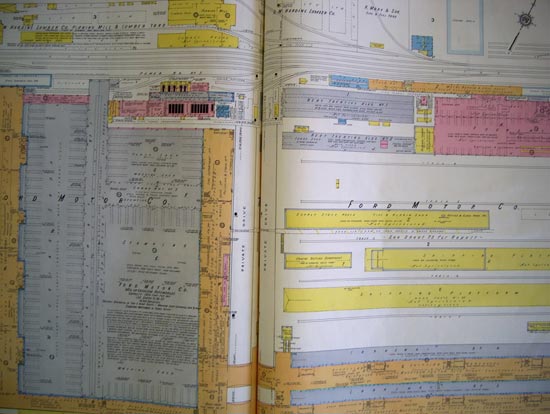 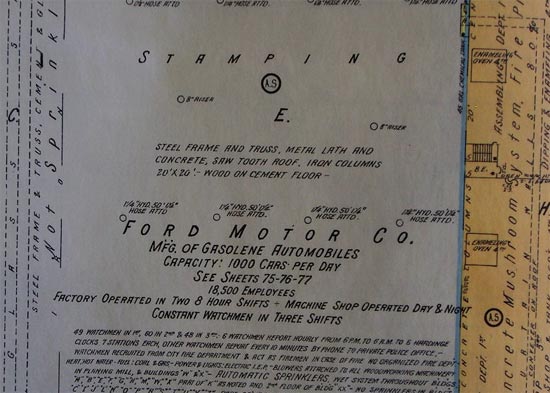 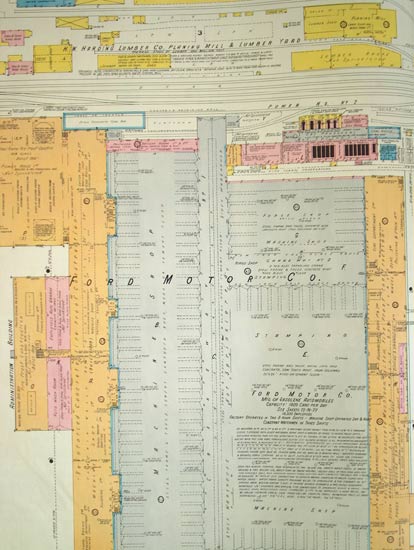 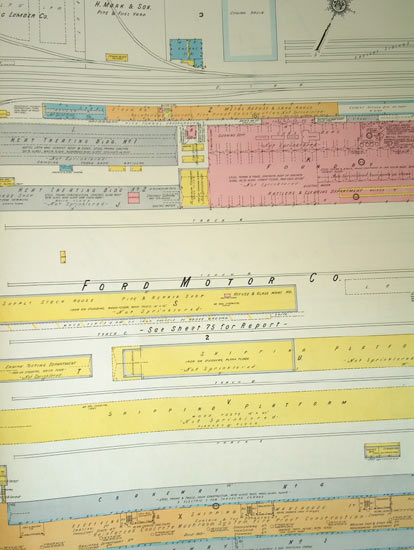 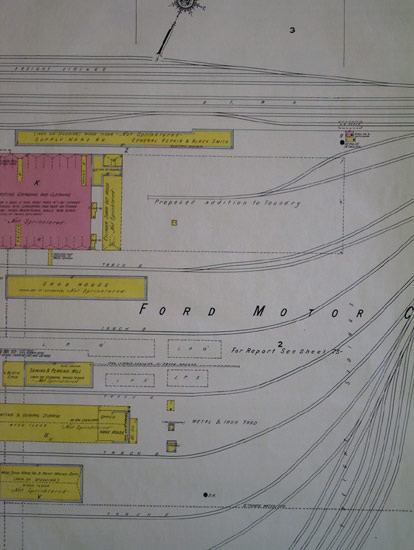 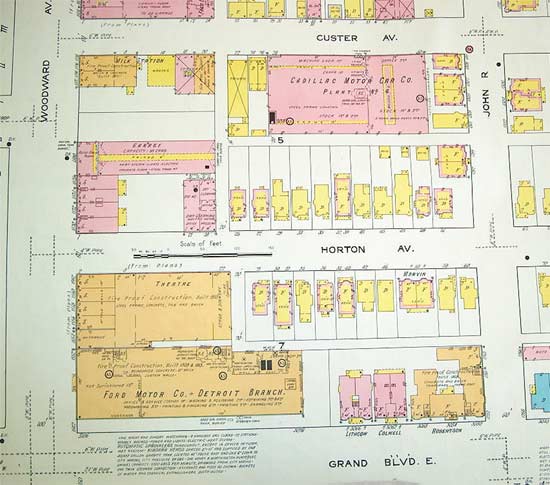 Notice Cadillac plant #4 above. 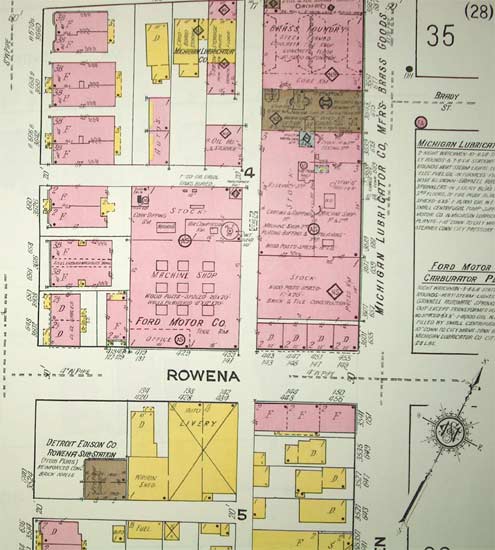 | ||||||||||||||||||||||||
Aiw Member Username: Aiw Post Number: 3713 Registered: 10-2003 Posted From: 209.216.150.127 |
What is/was this place? 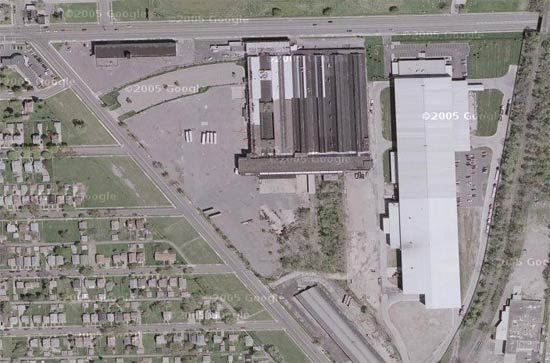 It's at West Warren & Lonyo just east of Wyoming? I came across it on Google Maps, and can't place it in my head... | ||||||||||||||||||||||||
Mikem Member Username: Mikem Post Number: 1411 Registered: 10-2003 Posted From: 208.54.94.65 |
Paige | ||||||||||||||||||||||||
Aiw Member Username: Aiw Post Number: 3715 Registered: 10-2003 Posted From: 209.216.150.127 |
Thanks, I thought it was something we already covered, but I didn't feel like digging though 6000 posts to find it...  | ||||||||||||||||||||||||
Sven1977 Member Username: Sven1977 Post Number: 69 Registered: 04-2004 Posted From: 209.220.229.254 |
I'm headed back down to the library tomorrow to close up loose ends on the Sanborn maps. I'll look at some of the 1941 maps too. Any requests? I still have 1915 Packard maps yet to post. | ||||||||||||||||||||||||
Jjaba Member Username: Jjaba Post Number: 1653 Registered: 11-2003 Posted From: 192.220.139.21 |
jjaba's father worked at 2460 E. Grand Blvd. Smith Envelopes. 1928-1965. After the envelope factory, it was a post offce. NW corner E. Grand Blvd and Dubois. Thanks. jjaba | ||||||||||||||||||||||||
Sven1977 Member Username: Sven1977 Post Number: 70 Registered: 04-2004 Posted From: 209.220.229.254 |
Here are the Packard Sanborn maps for 1915. 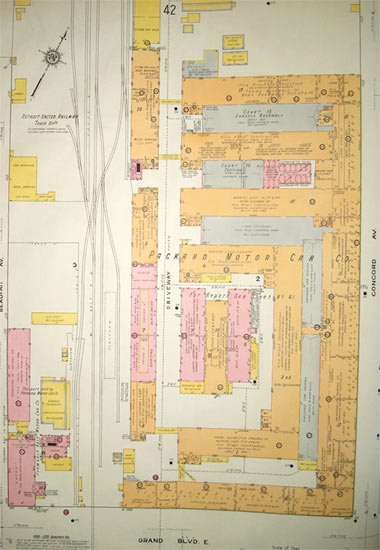 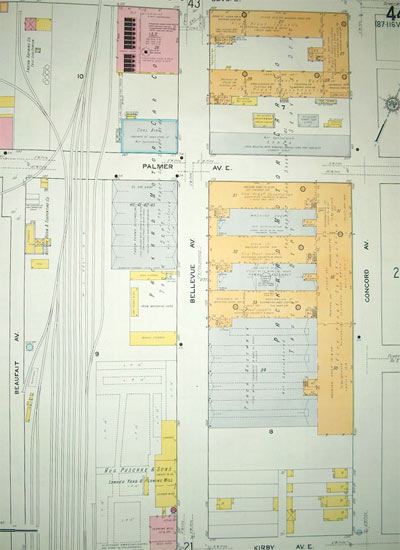 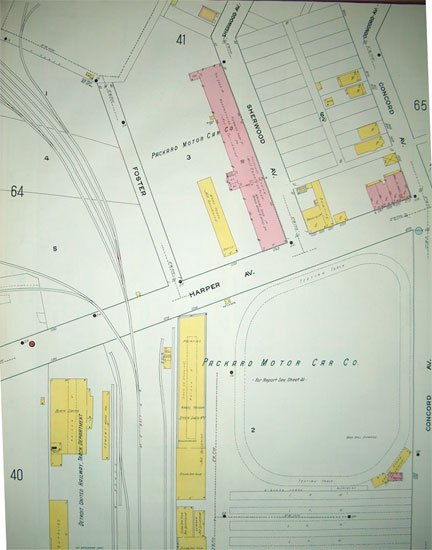 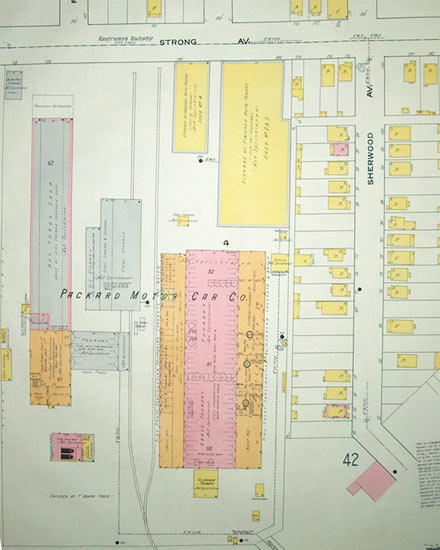 | ||||||||||||||||||||||||
623kraw Member Username: 623kraw Post Number: 610 Registered: 10-2003 Posted From: 68.41.224.200 |
North side of Warren Ave. just east of I-75 - any thoughts? 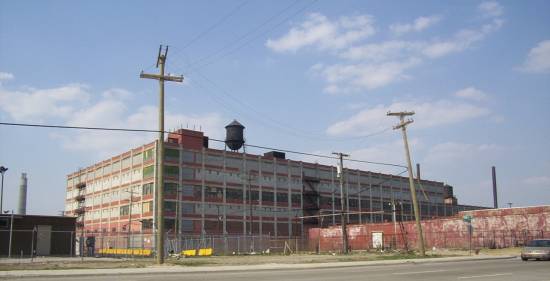 | ||||||||||||||||||||||||
Sven1977 Member Username: Sven1977 Post Number: 71 Registered: 04-2004 Posted From: 209.220.229.254 |
Cadillac. Lots of pictures earlier in the thread along with the Sanborn map layout. | ||||||||||||||||||||||||
Kathleen Member Username: Kathleen Post Number: 440 Registered: 10-2003 Posted From: 140.244.107.151 |
Some of the auto factory historians among us might find this of interest (from the Friends of DPL website): The Friends of the National Automotive History Collection Duplicates Sale, Saturday - Sunday, July 30 - 31, 10 am - 4 pm, DPL Extension Building, 801 W. Baltimore Avenue (2 blocks south and 2 blocks west of the old General Motors building). Here is your opportunity to purchase outstanding vehicle-related material while helping support the largest public automotive archive in the world, the Detroit Public Library's National Automotive History Collection. Sale items include car repair manuals from all makers, press kits, vintage magazines, photographs, automobile literature, paint color charts and more. $10 per day admission, Friends Members free. Call 313.833.4048 to join or renew your membership. | ||||||||||||||||||||||||
Jjaba Member Username: Jjaba Post Number: 1657 Registered: 11-2003 Posted From: 24.21.101.214 |
HUPP AUTOMOBILES. Robert C. Hupp invented a car company which made automobiles from 1909 to 1940. For a time around 1913, the cars were called R-C-H cars. So we have two names, mostly because of organization and reorganizations of his companies. Model 20 was introduced at the Detroit Auto Show in 1909. Hupp's idea was a car in "the working man's price range." Hupp's Detroit plants were at: R-C-H, 133 Lycaste St. Belleview Avenue. Jefferson Avenue. Milwaukee Avenue. Huppmobiles were made in Windsor, Canada and Cleveland in the Chandler Car Company plant (1929-36). The Cleveland plant was needed during a time of heavy sales. Total Hupp cars: 500,000. Best Yr.: 1929, 53,300. 1937. Huge strike. Very few cars all year. After that yr., very few cars were produced relative to the boomtimes. Last model, July, 1940. July, 1940, KAPUT. Huppmobiles were known for endurance. In 1910, Detroit's first police car was a Huppmobile. In 1916, a Huppmobile visited every American State Capitol. In 1932, a Huppmobile took 5th place in the Indy 500. In 1924, a Huppmobile raced a train from Cape Town to Johannesburg, South Africa. The train won. A rematch was held in 1990 and the Huppmobile won. There are no books written about Huppmobiles. The Huppmobile Club has 650 members (2005) and they own 800 Hupps. They print a Hupp Herald. In 1913, Hupp organized a factory in Windsor, Canada. Edward Budd built bodies for Hupp in Detroit. First of wood, then wood encased in steel, and later all-steel. The Hupp factory had a sales office on Woodward and Warren Avenues. They sold cars at 2021 S. Michigan Ave., Chicago, today known as Historic Auto Row. (Ford, Hupp, Chevy, Marmon, Locomobile, etc. were there on that street.) jjaba, tells it like it was. | ||||||||||||||||||||||||
Jjaba Member Username: Jjaba Post Number: 1658 Registered: 11-2003 Posted From: 24.21.101.214 |
Car Plants of Windsor, Canada. In 1926, 55 of 70 automobile factories in Canada were in Windsor, Ontario. Here's a list of most of them from olden days and beyond. Hupp, Graham, Ford, Dodge, Regal, Maxwell, Chalmers, Graham-Paige, Pierce Arrow, REO, Godfriedson, Studebaker, W.E. Seagrave, Dominion Motors, Canadian Motor Lamp, Champion Spark Plugs, Border Cities Industries, Menard Trucks, Tale Electric Cars Limited, Motor Products Limited, Canadian Commercial, Hudson, Packard, Auto Specialties, General Motors, Chrysler, Kelsey Wheel. Working conditions were terrible and there was much labour unrest. At Fords, lunch boxes were palletized and hoisted way above the workers. When their lunches were lowered, the workers had 20 minutes to eat and get back to work. Workers were forced to sign Yellow Dog Contracts saying they won't join a Union. To cope with the strees, workers would change jobs often. Sometimes, they were blacklisted by bosses seeking revenge. Layoffs could last a week, or an entire year depending on sales. Weather in the Canadian Prairies or anyplace in the British Empire might affect production and workers were sent home with impunity. Ford allowed workers to live only in certain areas in Windsor. They didn't want working class neighborhoods as enclaves. By 1945, the UAW had 51,000 workers in Canada. Windsor car factory immigrants came from many places. Syrians, Ukrainians, Finns, Serbs, are a few of the groups. Racial discrimination prevented very many Black people to work in car plants in early days. Recent emigrees and then Blacks were finally allowed to do the nastiest factory jobs such as foundry work. Woman had to fight for factory jobs and then for "Men's Wages." jjaba, research dept. Good Day. | ||||||||||||||||||||||||
Kathleen Member Username: Kathleen Post Number: 441 Registered: 10-2003 Posted From: 140.244.107.151 |
Jjaba: Thanks for the info on Hupp. It reminded me that I need to track down his exact date of death (1917 is the year) so that I can locate his grave, which I understand is in Woodlawn Cemetery. I'll put this on my To Do list for my next trip to the Burton. In the meantime, here's a link to the 1999 Detroit News article on the Hupmobile: http://info.detnews.com/joyrid es/story/index.cfm?id=78 (Message edited by Kathleen on April 23, 2005) | ||||||||||||||||||||||||
Jjaba Member Username: Jjaba Post Number: 1659 Registered: 11-2003 Posted From: 24.21.101.214 |
Thanks for the nice article about Huppmobiles. The photos were wonderful, with all those restored colors. jjaba apologizes. The Hupp plant on Bellevue was reported as Belleview. jjaba not too good with Eastside streets. jjaba, Proudly Westside. | ||||||||||||||||||||||||
Mikem Member Username: Mikem Post Number: 1416 Registered: 10-2003 Posted From: 68.43.12.165 |
AIW, Graham-Paige to be more accurate. Thanks for the tip Kathleen! See you there. Sven, are you keeping high-resolution copies of all these maps? I might need to see a few in greater detail. Westside for jjaba, and Lowell, Rouge alumnus: 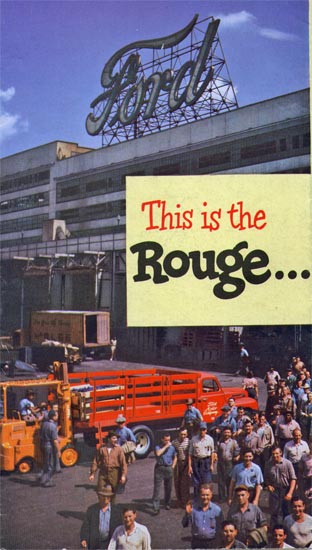 | ||||||||||||||||||||||||
Aiw Member Username: Aiw Post Number: 3718 Registered: 10-2003 Posted From: 65.92.102.120 |
Thanks for the heads up about the sale Kathleen. I've already marked it on the calendar. | ||||||||||||||||||||||||
Mikem Member Username: Mikem Post Number: 1417 Registered: 10-2003 Posted From: 68.43.12.165 |
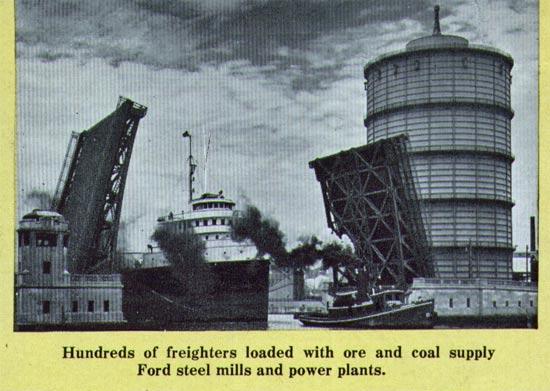 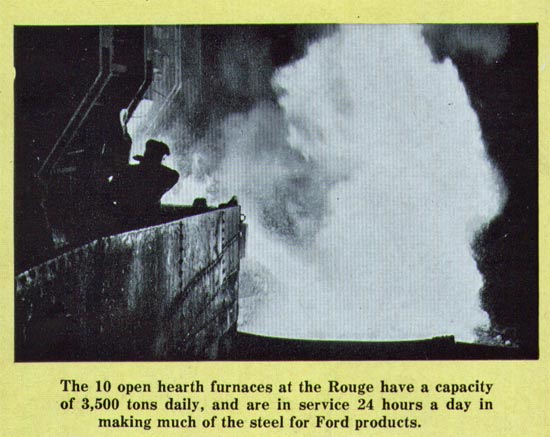 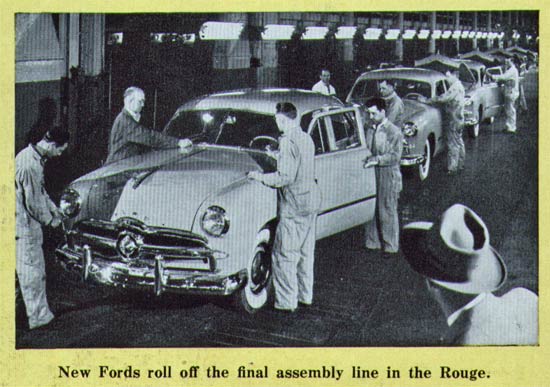 Which year's models are those? | ||||||||||||||||||||||||
Mikem Member Username: Mikem Post Number: 1418 Registered: 10-2003 Posted From: 68.43.12.165 |
Hank the Deuce thanks you for visiting! 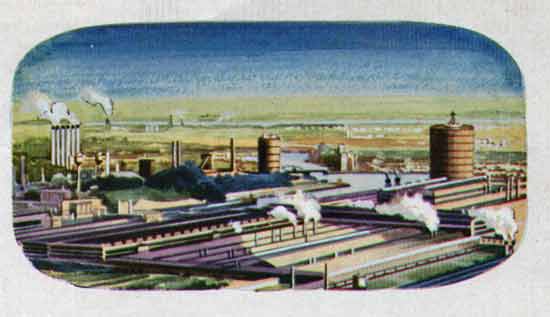 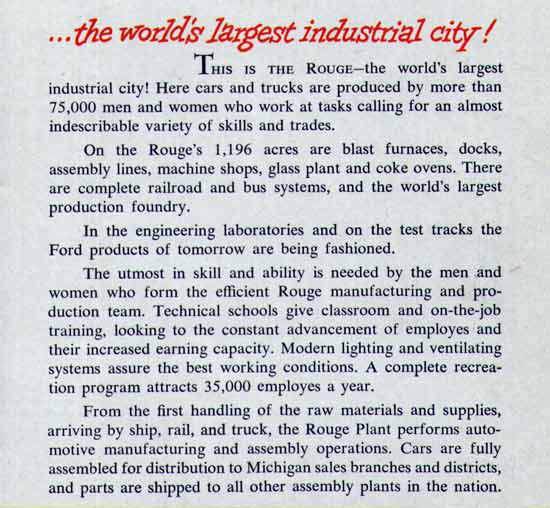 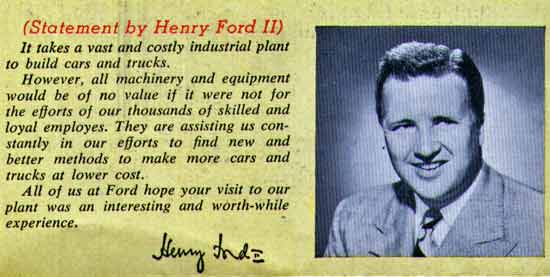 | ||||||||||||||||||||||||
Mikem Member Username: Mikem Post Number: 1419 Registered: 10-2003 Posted From: 68.43.12.165 |
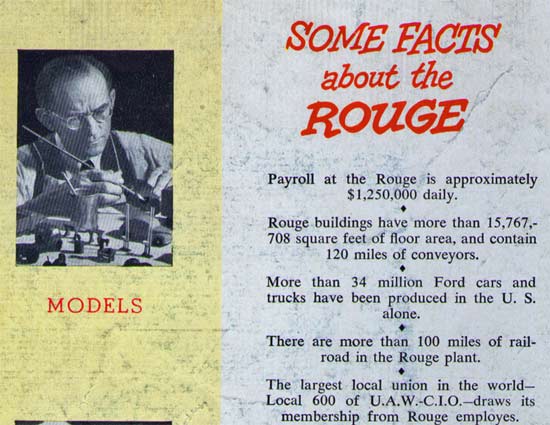 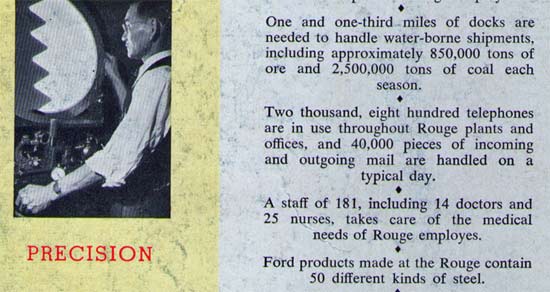 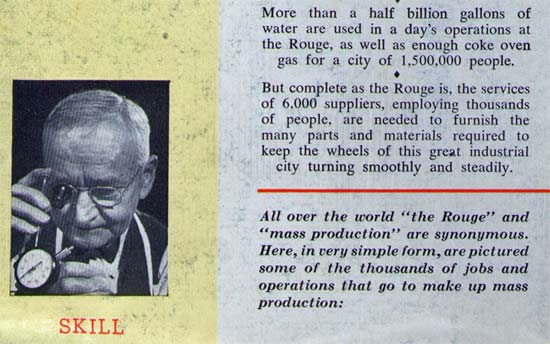 Does anyone remember giving donations of walnut shells to Ford for their use in industrial water purification? | ||||||||||||||||||||||||
Mikem Member Username: Mikem Post Number: 1420 Registered: 10-2003 Posted From: 68.43.12.165 |
Skipping ahead to step 7: 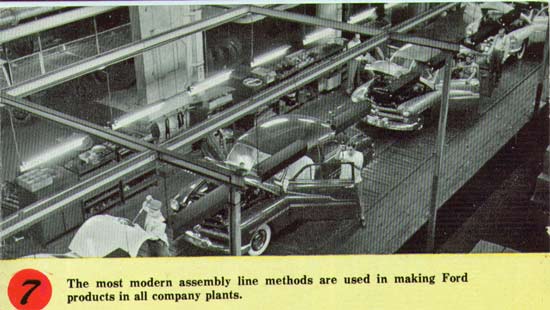 | ||||||||||||||||||||||||
Mikem Member Username: Mikem Post Number: 1421 Registered: 10-2003 Posted From: 68.43.12.165 |
The Rouge's importance in the big scheme was that it made most of the parts for all of the other Ford assembly plants: 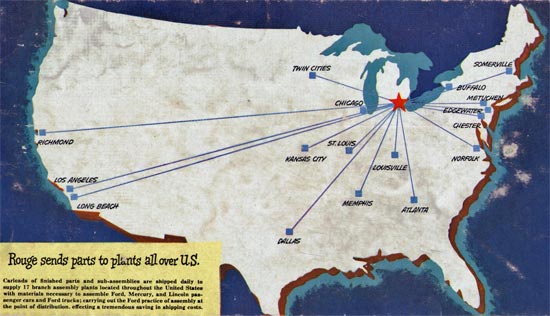  | ||||||||||||||||||||||||
Bob_cosgrove Member Username: Bob_cosgrove Post Number: 47 Registered: 03-2005 Posted From: 207.74.112.174 |
The photo of the plant east of I-75 on the north side of Warren that Kraw623 posted on 4-22-05 is a former Fisher Body plant number 10. Bob Cosgrove | ||||||||||||||||||||||||
Patrick Member Username: Patrick Post Number: 2265 Registered: 10-2003 Posted From: 68.255.166.5 |
so is there anything in the world that compares with the mighty old Rouge...yet? | ||||||||||||||||||||||||
| Discuss Detroit » Hall of Fame Threads » Old Car Factories » Old Car Factories - 8 |
|